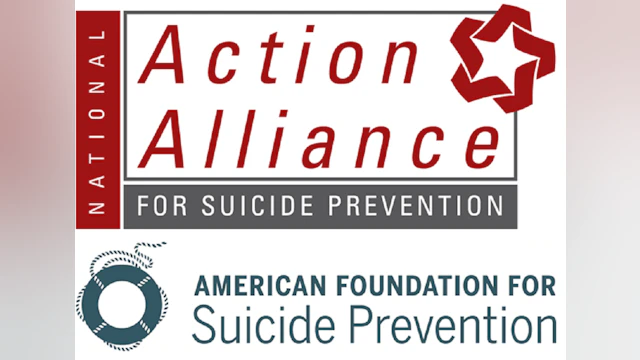MEDIA CONTACTS:
Action Alliance: Kim Torguson ([email protected]; 202-572-3737)
AFSP: Alexis O’Brien ([email protected]; 347-826-3577)
National public-private partners join efforts to reduce the annual suicide rate 20 percent by 2025 – saving tens of thousands of lives in the U.S.
WASHINGTON [January 31, 2017]— The National Action Alliance for Suicide Prevention (Action Alliance), the public-private partnership working to advance the National Strategy for Suicide Prevention (NSSP), and the American Foundation for Suicide Prevention (AFSP), the nation’s largest suicide prevention organization, are uniting efforts to reduce the annual suicide rate 20 percent by 2025 in response to the rising suicide-related deaths over the last 16 years. Suicide remains one of the 10 leading causes of death in the U.S. In 2015, more than 44,000 people in the U.S. lost their lives to suicide, according to the Center for Disease Control and Prevention (CDC).
“To combat this preventable issue and reduce morbidity and mortality in this country requires multi-sector coordination, alignment and engagement,” said Robert Turner, Private Sector Chair of the Action Alliance and Retired Senior Vice President of Union Pacific Corporation. “The Action Alliance – with more than 250 partner organizations involved, including AFSP – is uniquely positioned, given its various cross-sector representation, to progress and elevate this unified goal.”
“We are excited that the Action Alliance is joining forces with AFSP in support of the 20 percent by 2025 goal. By collaborating with partners across public and private sectors on actionable strategies, like the Action Alliance’s Zero Suicide model and our Project 2025 initiative, we are confident we will reduce suicide rates in the U.S.,” said AFSP CEO Robert Gebbia. “We know we can’t do this alone. In making this a national goal, and by continuing our efforts to form strategic partnerships, we believe we can save tens of thousands of lives.”
Using the latest techniques in dynamic modeling, AFSP’s Project 2025 is focused on four critical evidence-based areas that can contribute to risk reduction, one of which is identifying people at risk in large health care systems. By focusing on areas where burden exists, this model helps to identify effective interventions already in place that can advance this national goal, such as Zero Suicide – a leading national effort catalyzed by the Action Alliance.
“Working collaboratively towards a common national goal allows us to unite our efforts to make real progress in suicide prevention, and define our approach with urgency, over the next decade,” said Carolyn Clancy, MD, Public Sector Chair of the Action Alliance and Deputy Under Secretary for Health Organizational Excellence at the U.S. Department of Veterans Affairs (VA). “This is an opportunity for the Action Alliance and its partners to advance the NSSP and transform health care systems – an identified focus area of the project and a key priority of the Action Alliance.”
Among many of its priorities to advance this national goal, the Action Alliance is scaling up implementation of its Zero Suicide Model – an evidence-informed quality improvement approach to improving suicide care in health and behavioral health care systems. Zero Suicide in healthcare is a key strategy to reducing the suicide rate by 20 percent by 2025.
“Studies have shown that health care systems can play an important role in preventing suicide deaths,” said Jerry Reed, PhD, Senior Vice President of Practice Leadership at the EDC Inc., and Executive Committee member of the Action Alliance. “Hundreds of health and behavioral health care systems are already implementing Zero Suicide, and early results indicate this model has potential to significantly reduce suicide deaths of patients under care.”
More about the National Strategy for Suicide Prevention (NSSP)
The revised NSSP, a Report of the U.S. Surgeon General and the Action Alliance, emphasizes the role every American can play in protecting their friends, family members, and colleagues from suicide. It also provides guidance for schools, businesses, health systems, clinicians and many other sectors that takes into account nearly a decade of research and other advancements in the field since the last strategy was published.
The Action Alliance’s Zero Suicide is a key concept of the NSSP through which health and behavioral health care systems commit to making suicide prevention a core priority within their systems, and implement processes and strategies that prevent suicide and significantly improve their care of patients at risk for suicide.
Launched in October 2015, Project 2025 is a high-impact, collaborative initiative developed by AFSP, aimed at achieving the organization’s bold goal of reducing the annual suicide rate 20 percent by 2025. Using a dynamic systems model approach based on what the evidence tells us about suicide, AFSP has determined a series of actions and critical areas (Firearms industry, Emergency departments, Large health care systems, and in Criminal justice settings) to help us reach our goal. With this approach, we reach across all demographic and sociological groups to have the greatest impact for suicide prevention and the potential to save thousands of lives within the next 10 years. If we work collectively to expand the above interventions into these critical areas – cumulatively, we can expect to save nearly 20,000 lives through 2025.
# # #
FOR MEDIA PARTNERS:
Research shows that the media may influence suicide rates by the way they report on suicide. Evidence suggests that when the media tells stories of people positively coping in suicidal moments, more suicides can be prevented. We urge all members of the media working on these stories to refer to the Recommendations for Reporting on Suicide for best practices for safely and accurately reporting on
